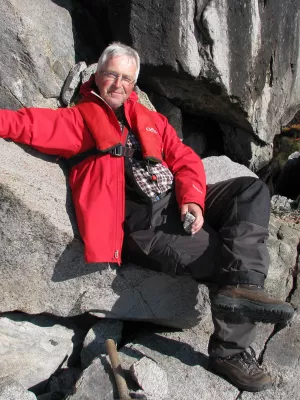
Leif Johansson
Professor emeritus

The eastern boundary of Sveconorwegian reworking in the Baltic Shield,defined by 40Ar/39Ar geochronology across the southernmost Sveconorwegian Province
Author
Summary, in English
New 40Ar/39Ar dates of hornblende, biotite and muscovite from 13 localities along a 130 km transect in southern Sweden provide insight into the cooling and exhumation history during Sveconorwegian orogeny, from 970 to 880 Ma. The Eastern Segment represents Baltican continental crust underthrust below the western Sveconorwegian terranes at 990–970 Ma. The western part of the Eastern Segment consists of amphibolite- to granulite-facies pervasively deformed gneisses, in which hornblende and biotite 40Ar/39Ar dates between 901 and 889 Ma record the cooling and exhumation through 530–330 °C. In the easternmost part of the orogen is a c. 25 km wide boundary zone characterized by non-penetrative greenschist- to amphibolite-facies deformation zones. There, muscovite apparent ages range from 882 to 902 Ma, biotite from 892 to 906 Ma, and hornblende from 1.37 to 1.47 Ga, meaning that muscovite and partly biotite record Sveconorwegian overprint, while amphibole was disturbed. Several biotite samples record ages in the interval 0.9–1.4 Ga, reflecting excess Ar components. East of the Sveconorwegian Province, in the Blekinge-Bornholm Province, hornblende and mica apparent ages spread between 1.13 and 1.41 Ma, implying that neither mineral underwent complete Sveconorwegian resetting. The data pattern reflects that the Eastern Segment experienced slow cooling (∼3 °C/Ma) from peak metamorphism of 800–700 °C at 980–960 Ma to 900 Ma, when significant cooling though greenschist-facies conditions set in (∼26 °C/Ma). This cooling was related to tectonically driven extension, accommodated by greenschist-facies shear zones along the eastern boundary zone.
Department/s
- Department of Geology
- Lithosphere and Biosphere Science
Publishing year
2018
Language
English
Pages
201-217
Publication/Series
Precambrian Research
Volume
307
Links
Document type
Journal article
Publisher
Elsevier
Topic
- Geology
Keywords
- Neoproterozoic
- Sveconorwegian
- Orogeny
- Exhumation
- cooling age
- 40Ar/39Ar thermochronology
Status
Published
ISBN/ISSN/Other
- ISSN: 0301-9268

